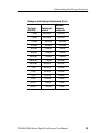
Understanding Oscilloscope Functions
TDS1000/2000-Series Digital Oscilloscope User Manual
21
Oscilloscope models with 60 MHz or 100 MHz bandwidth sample at
rates up to 1 GS/s. Models with 200 MHz bandwidth sample at rates
up to 2 GS/s. In both cases, these maximum sample rates are at least
ten times the bandwidth. These high sample rates help reduce the
possibility of aliasing.
There are several ways t o che ck for aliasing:
H Turn the SEC/DIV knob to change the hori zontal scale. If the
shape of the wave form changes drastic ally, you may have
aliasing.
H Select the Peak Detect acquisition mode (described on page 17).
This mode samples the highest and lowest values so that the
oscilloscope can detect faster signals. If the shape of the
waveform changes drastically, you may have ali asing.
H If the trigger frequency is faster than the display information, you
may have aliasing or a waveform that crosses the trigger level
multiple times. Examining the waveform should allow identify-
ing whether the shape of the signal is going to allow a single
trigger crossing per cycle at the selected trigger level. If multiple
triggers are likely to occur, select a trigger level that will generate
only a single trigger per cycle. If the trigger frequency is still
faster than the display indicates, you may have aliasing.
If the trigger frequency is slower, this test is not useful.
H If the signal you are viewing is also the trigger source, use the
graticule or the cursors to estimate the frequency of the displayed
waveform. Compare this to the Trigger Frequency readout in the
lower right corner of the screen. If they differ by a large amount,
you may have aliasing.


















